Horse Mounted Cavalry in World War II - An Anachronism or Tactical Sense
The modern view of World War II is one of huge armoured formations dealing out death and destruction on all sides whilst being impervious to incoming fire. Cavalry, at least those in the traditional sense (not tank units retaining traditional regiment names) who ride into battle on horses, seem to be as out of place on a modern battlefield as would be a flintlock musket. But is this really the case?
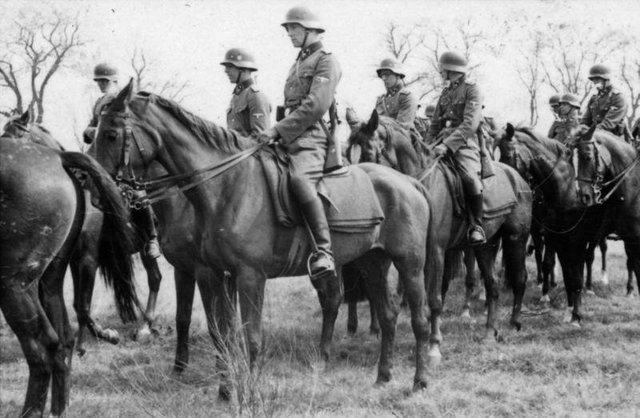
SS Cavalry in Russia 1941
When we look at the early stages of World War I and in particular at the cavalry actions of 1914, we see cavalry taking serious casualties from machine gun fire and being unable to achieve their objectives. Heinz Gudarian notes this in the opening section of his book "Achtung Panzer" and reflects on how the advent of the machine gun had restricted ability of troops to manoeuvre before the enemy in modern warfare (speaking of World War I and interwar period). Despite this it did not stop cavalry from performing useful duties during the First World War, cavalry commanders developed tactics to suit the situation in which they found themselves, officers leading cavalry units across open terrain in the face of machine guns tended to have a somewhat Darwinian effect and effective cavalry tactics developed to contend with the new situation. At the beginning of the Second World War all major armies had horse mounted cavalry formations. Some of these nations retained their cavalry through to the end of the war and beyond, while others altered the role of these units to be armoured, mechanised or even leg mobile infantry. To understand the question asked in the title, we must understand why cavalry were used in this modern world of mechanised warfare. There are two very simple reasons why horsed cavalry was still used at this time (both are still valid to this day):
1: Terrain suited horses and was difficult or impassable to contemporary military vehicles.
2: Cavalry units were available to perform a given task when other troops capable of the task were not.
These were the only reasons that cavalry were retained during this period, armoured vehicles would always be preferred over horses for obvious reasons.
While there were definitely senior commanders whose nostalgia had replaced what little understanding they ever had, who yearned for the days of knee to knee cavalry charges with sabres and lances gleaming in the sunlight, the realities of modern warfare generally prevailed over nostalgia. That these misconceptions actually existed can be seen from the results of early British experiments with the use of tanks on Salisbury plain in the 1930s, cavalry units were frequently judged to have engaged and destroyed armoured formations in open battle. This sort of wishful thinking came from some officers who completely failed to learn the lessons of cavalry operations in the First World War or selectively understood those lessons that supported their own preconceptions.
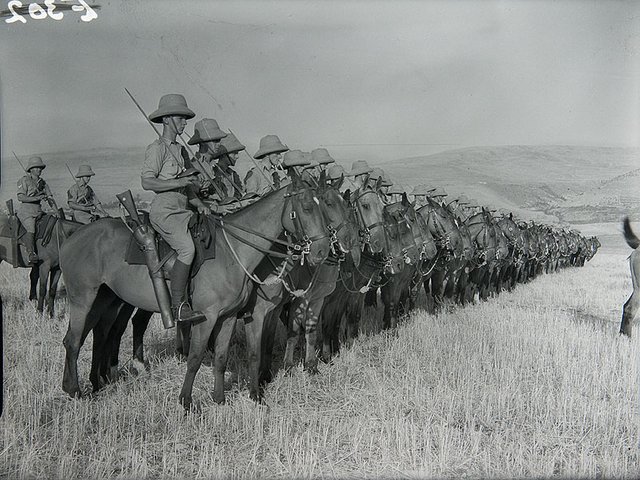
British Cavalry in Palestine 1940
However my question was about whether cavalry was an anachronism in World War II. When we look at the use of cavalry in World War II it performed a useful function, in general cavalry was used in places that were (or were believed to be - the French DLC in the Ardennes) unsuited to vehicles. We should also note that the cavalry units were generally well armed for the task they were expected to perform and followed a tactical doctrine that allowed them to use their strengths to advantage whilst reducing their weaknesses as far as possible. It was not uncommon for a cavalry division to have light armour, anti-tank and artillery units as part of its organisation. If we look at the French Division Legere de Cavalerie* (DLC) of 1940 we can see this mixed order of battle. The DLC had to mounted cavalry regiments (32 x LMGs, 48 x rifle grenade launchers, 8 x MMGs, 4 x 60mm mortars and 4 x 25mm Anti-Tank guns), a Mechanised Dragoons Battalions (11 x AMR [Tankette/Light Tank], 26 x LMGs, 24 x rifle grenade launchers, 12 x MMGs, 1 x 60mm mortar, 4 x 81mm mortars and 4 x 25mm Anti-Tank guns), an Armoured Reconnaissance Regiment (armoured car, light tank and motorcycle) and an Artillery regiment (12 x 75mm, 12 x 105mm & 8 x 47mm Anti-Tank Guns). Although this formation is numerically weaker than a contemporary infantry division, it is far more mobile and has greater firepower than its size would suggest. Saying this, the DLC, suffered from the same faults as did the rest of the French army: poor strategic leadership and a lack of light anti-tank weapons. A later Cavalry formation, the 8th SS Cavalry Division, possessed a battalion of armoured tank destroyers.
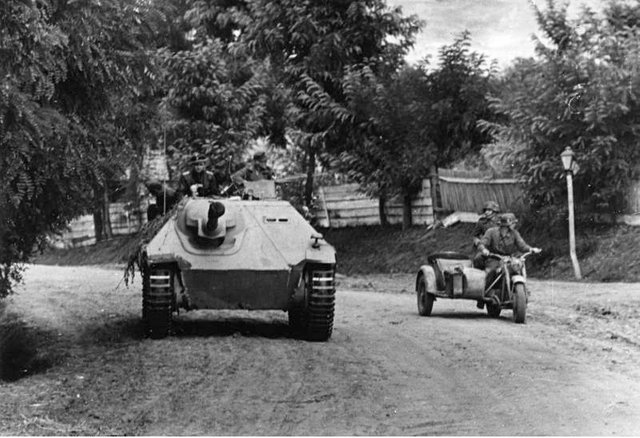
Jagerpanzer 38(t) Hetzer & motorcycle combination of 8th SS Cavalry Division "Florian Geyer" 1944
Tactically, horse mounted cavalry in World War II operated mostly in the "Dragoon" tactical style, they used their horses for mobility and dismounted to fight. If we look at the famous Polish Ulhans, whilst they retained Sabres, their traditional lances were gone and units were fully equipped with rifles, machine guns, anti-tank rifles and even potent anti-tank guns. These units were tactically flexible and mobile, they were not intended solely for some gallant death or glory charge, although should the tactical situation warranted it, they were quite capable of turning the clock back a century or two and putting their enemies to the sword. Both the Soviet Union and the axis forces made extensive use of cavalry during the fighting on the Eastern front. The terrain in the Eastern Front and Central Europe varied widely and not all of it was friendly to the vehicle technology of the time, this being the case, numerous cavalry divisions served on that front: Germany (1 Army + 2 SS Divisions), Hungary (1 Division), Italy (1 Division), Romania (6 Divisions - 1 converted to mechanised in 1944) & the Soviet Union (80+ Divisions - some deployed to face the Japanese). Mobility was vital over the vast landmass that was being fought over and all-terrain vehicles, particularly armoured vehicles were expensive and in short supply and so cavalry again found favour. The German, particularly the SS, cavalry units found another duty during the war on the Eastern Front, anti-partisan warfare where the mobility of cavalry over poor terrain made them ideal for chasing down insurgents in the hills forests and marshes behind the front line on the Eastern front.
Where most Western armies turned their cavalry into armoured formations, there was an exception, the American 1st Cavalry Division was, rather than mechanised into an armoured formation, dismounted and turned into an infantry division (although still retaining the cavalry designation). Fighting in the Philippines, several senior officers noted that the additional mobility offered by cavalry in the poor terrain could have made a positive contribution to the campaign. The reason given for not remounting the 1st Cavalry Division was the strain on logistics that attempting to move the division's horses in the Pacific would cause.
In Europe, another American, General George S. Patton remarked that an American cavalry division and its attached, artillery could have proved incredibly effective in the fighting in Tunisian and Sicilian, mountainous terrain. Have this capability been available, the mobility of cavalry and pack howitzer artillery would have created serious problems for the enemy. He noted that he was of the belief that had a properly equipped division of American cavalry been available, the evacuation of Sicily by the German and Italian forces would not have been possible. This is an odd situation where a modern general, indeed, a master of mechanised warfare lamented the absence of old-fashioned horse mounted cavalry.
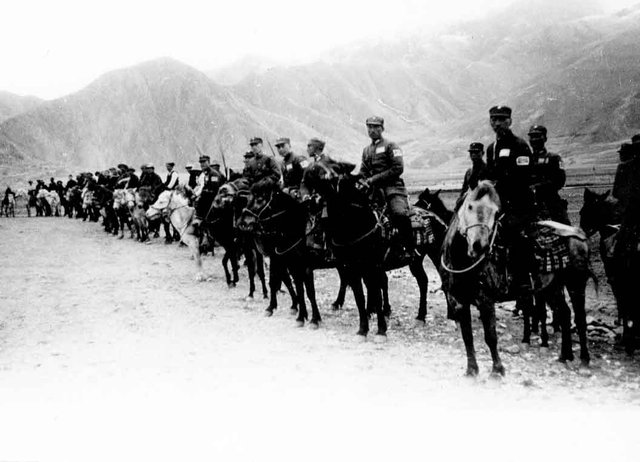
Chinese Cavalry 1943
Sometimes, there was no alternative to the use of cavalry; either no modern equipment was available to perform the task (British cavalry regiments in infantry divisions after Dunkirk) or the were no other troops available; Otto Skorzeny mentions a well mounted cavalry unit riding past his own defensive positions, going out to engage the Russians during the last days of the war in Europe. When cavalry are the only mobile troops available, then cavalry are an excellent resource, this could also be said of the American Special Forces engaged during the early stages of the Afghan war, making use of what you have available beats crying over a lack of resources hands down.
While the cavalry charge of past centuries was just that, past, there were still small scale charges against infantry (the Polish 18th Ulhans at Krojanty 1939, Italian Savoia Cavalleria at Izbushensk 1942 & US 26th Cavalry at Morong 1942) that proved that charging cavalry will break infantry under the proper circumstances. In general these charges were spur of the moment actions that were either forced upon the cavalry or as in the case of the 18th Ulhans, too good an opportunity to miss. This was not how Second World War cavalry was intended to be used.
In conclusion, we can say that the cavalry units that served in the Second World War were not the anachronism that they appeared to be. It is perhaps best to think of them as mobile infantry units, well suited to poor terrain conditions, well armed and able to meet developing threats. The cavalry performed a set duty, nobody expected them to go head-to-head with armoured units, indeed the charge at Krojanty was stopped dead in its tracks by the intervention of a small Armoured Car unit and so it is important that we do not try to move the cavalry from the reality in which they existed. The realities of cavalry warfare were that they suffered terribly against emplaced machine guns, armoured vehicles and air strikes. This however does not mean that they could not be used, or were not used, effectively in other situations.
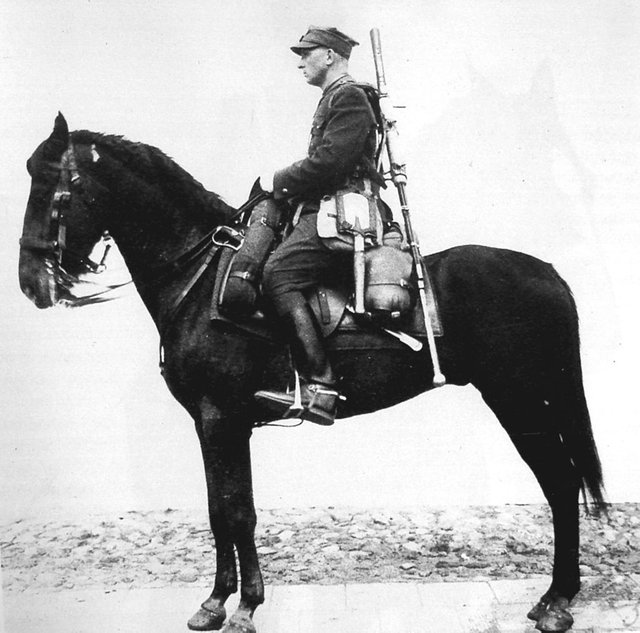
Polish Cavalry man with an Anti-Tank Rifle 1939
Bibliography
British and Commonwealth armies in 1939-43 - Mark Bevis
History of the Second World War - Winston S. Churchill
Commando Extraordinary (Otto Skorzeny's Military Biography) - Charles Foley
Axis Cavalry in World War II - Jeffrey Fowler
Panzer Leader - Heinz Guderian
Achtung Panzer - Heinz Guderian
History of the Second World War - Basil Liddel Hart
World War II US Cavalry Units - Gordon Rottman
France 1940 - Alan Shepperd
A New Excalibur - A. J. Smithers
*1940 DLC Order of Battle found at En Pointe Toujours
The excellent Nafziger Lists were extremely helpful in writing this article. Here is a downloadable, searchable Finding Aid that will help locate the subject that you are looking for in this huge collection.

In 1942-1943 on the Eastern Front, the Russians actively used the cavalry in conjunction with tanks and aircraft to break through the German defense and rapid offensive. This tactic proved to be very effective.
Indeed, the Soviets units being the only cavalry to mix cavalry with battle tanks by design and so late in the war as well (also the only nation to form Corps level Cavalry formations). I always wondered about the sense of this, but I suppose what when you lack motorised infantry in and are on the offensive, but have lots of cavalry, the cavalry will do. It might be interesting to look in detail at the actions these Russian Cavalry Corps fought in. This also occurred during the last days of the war on the German side with SS cavalry units being gathered into combat units (Brigade/Division) with whatever else was available, but not as a considered tactical concept.
Another Great Post...Very well researched and brilliantly documented.
Thanks, I'm glad that you liked the post.
You are welcome!
||BEST||
@minnowpond1 has voted on behalf of @minnowpond.
If you would like to recieve upvotes from minnowponds team on all your posts, simply FOLLOW @minnowpond.
Beep! Beep! This humvee will be patrolling by and assisting new veterans, retirees, and military members here on Steem. @shadow3scalpel will help by upvoting posts from a list of members maintained by @chairborne and responding to any questions replied to this comment.
Congratulations @audax, this post is the third most rewarded post (based on pending payouts) in the last 12 hours written by a User account holder (accounts that hold between 0.1 and 1.0 Mega Vests). The total number of posts by User account holders during this period was 2558 and the total pending payments to posts in this category was $2418.48. To see the full list of highest paid posts across all accounts categories, click here.
If you do not wish to receive these messages in future, please reply stop to this comment.
This post was upvoted & promoted by @monitorcap traffic bot.
Send minimum 1 SBD to @monitorcap bot with your link in MEMO field and recieve random upvote & post promotion in our daily TOP posts listings. @monitorcap - where 'seen' matters !